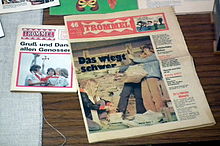Drum (magazine)
| drum
|
|
|---|---|
| description | Youth magazine |
| language | German |
| publishing company | Young World ( GDR ) |
| Headquarters | Berlin |
| First edition | 1958 |
| attitude | 1991 |
| Frequency of publication | weekly |
| Sold edition | 1.2 million copies |
| editor | Central Council of the FDJ |
| ISSN (print) | 0323-8709 |
Drum is the name of a weekly newspaper that appeared in the GDR from 1958 to 1991 by the Junge Welt publishing house . The circulation was at times 1.2 million copies. It was the organ of the Central Council of the FDJ for the Thälmann Pioneers and other pupils from 4th to 7th grade and thus formed the continuation of the ABC newspaper for the young pioneers .
It was sold directly through schools on Thursdays at a price of ten pfennigs, but was also available by subscription or at the newspaper kiosk. Drum reporters were named among the pioneers who reported on the pioneering work and thus incorporated the basic work into the reporting. Similar to the FRÖSI, the newspaper was recommended by schools as reading material.
construction
The newspaper had 16 pages with content on politics and school life, but also sports, music, literature (reading samples), puzzles, comics, jokes (“Piefke and Schniefke”, “Happy Minute”) and letters to the editor.
On special occasions, e.g. B. Pioneer Meetings, special editions have been issued.
attitude
In 1991 the drum was discontinued with issue 4. For a few months a follow-up magazine called Siehste! based on the model of western youth magazines such as Bravo . In the same year, the company was hired due to a lack of demand. Existing subscriptions were initially switched to Bravo magazine , but delivery was discontinued very quickly due to corresponding contradictions and a lack of contractual bases.
Web links
Individual evidence
- ↑ The magazine should presumably follow the tradition of The Drum which appeared in the Weimar Republic . Link to the magazine for workers and farmers' children . This was published from 1926 to 1933 by the Berliner Verlag Junge Garde and was the successor to the magazine Jung Spartakus . (Proof in the catalog of the German National Library ).
